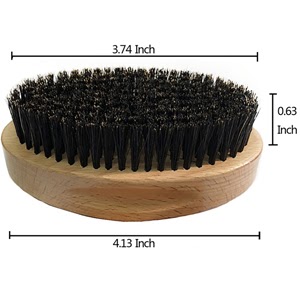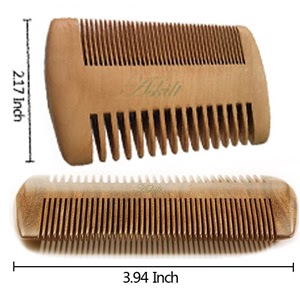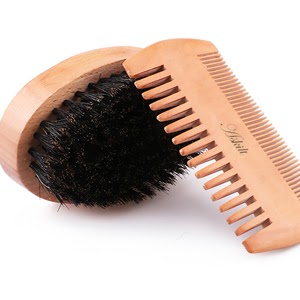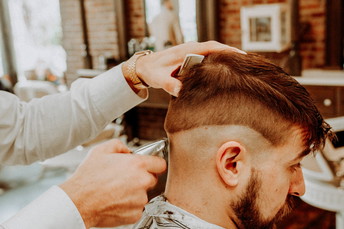Beard Comb Vs Brush: When And Why to Use Each?
“Should I use a boar bristle brush, a comb, or both?”
This is one of the questions most beginners ask when trying to become better-informed beardsmen.
So, get this:
Based on beard culture, one should always use a brush for beard oil or beard balm distribution. Then, combs help with untangling facial hair strands and the removal of dirt, dust, and crumbs.
This makes sense, right?
However, beards grow differently in length and texture from one person to another. And, therefore, require different grooming tools.
So, what now?
Well, follow me as I straighten out the debate between beard combs and beard brushes. In this post, you’ll discover;
- The main difference between a beard comb and a brush
- When it is better to brush or comb or use both tools on your beard
- Professional answers to frequently asked questions about comb vs brush for the beard
So:
First thing first…
What Is A Beard Brush?

A beard brush is a facial hair grooming tool characterized by a broad handle/body and bristle.
Now:
Depending on how you hold and maneuver the handle/body, the bristle distributes beard oil, detangles hair, or/and removes dirt.
Note:
A brush can either have natural bristles or synthetic ones.
Natural beard brush bristles are collected from boars or horses. Moreover, facial hair brushes with natural bristles are expensive. However, they have the best equilibrium between flexibility and stiffness. Plus, this bristle quality promotes efficient oil distribution without skin aggravation.
On the other hand:
Beard brushes with synthetic bristles made of plastics are readily available but tend to cause hair breakage. Yet, they are animal-friendly, vegan-friendly, and cost-effective. Nevertheless, they are harmless on thick, coarse whiskers than on fine hair strands.
What Is A Beard Comb?

So:
Beard combs have a rather slender body (that can be of any length) and a set of teeth. They are either carved out of wood or synthetically made from plastics or metal.
When you move a comb through hair or a beard, the teeth detangle strands, remove dirt, and help to straighten or restyle your facial hair.
Now, get this:
When choosing beard combs, consider teeth spacing – i.e. the width between each tooth.
If you have a thick mane, a wide-tooth comb will pass through easier and without damage than a narrow one.
More so, note that plastic combs usually cause hair static and are not as durable as wooden ones.
The Main Differences Between Beard Comb And Brush

| Beard Brush | Beard Comb |
| Uses bristles to groom the hair. | The main grooming feature is a set of teeth. |
| The broad, bulk body offers better grip and control. | The slender body makes it portable and easy to carry around. |
| Great for easy distribution of beard oil, balm, or butter. | Works best at removing dirt, food particles, dust, and the detangling or restyling of a beard. |
| Best for short beards. | Best for long or fully grown manes. |
| Gentler on the hair. | Combs with narrow teeth gaps can be aggressive to the point of pulling hair out of their follicles. |
When Should You Use a Beard Comb or Brush? And When Should You Use Both?

When To Use Beard Brushes
- During the early stages of your facial hair growth journey (mostly during the month 1-2). With a brush, you can train your mane and decide the direction it should grow.
- When you need to distribute beard oil, beard balm, or butter evenly and effectively.
- Use a beard brush when grooming a dry whisker to give it a fuller, thicker appearance.
- Also, during the early stages, beard brushes are the most effective to remove dead skin cells, frizzy hair, and oil built-up.
- For cleaning out and conditioning both a fully grown and young beard.
When To Use Beard Comb
- Facial hair combs are a necessity for beards that are older than 3 months.
- Use combs to detangle knots and get rid of flyaways.
- Combs are easier to control and offer the best styling results, especially when your mane is thick, long, and full.
- When you need a handy, portable grooming tool that fits into the pocket for regular beard restyling, use a beard comb.
- If you prefer grooming your beard when it’s damp, combs go gently and won’t pull out your hair.
- Mustachioed men need to constantly redirect hair away from their mouths. If this is you, you need a portable beard comb.
- You need a comb to get a uniform look when trimming the facial hair with a pair of scissors.
When To Use Both a Facial Hair Comb And Brush
Basically:
Once your beard reaches 3 months of age, it’s time to have both of these tools in your drawer.
As the beard grows longer, a pocket-size comb and brush become a must. But, you’ll need a brush for the effective distribution of beard care and styling products.
Additionally, a comb functions as a straightener, restyler, and tool for removing build-ups.
In Conclusion.
Both beard combs and beard brushes are must-haves in the grooming toolkits of every beardsman.
Though, at the early stages of your beard, all you need is a brush. But, as your whisker grows longer and thicker, a beard comb becomes an essential tool too.
Anyway:
If you have questions, thoughts, or experiences to share about these two handy beard grooming tools, feel free to use the comment box below. Keep becoming a better-informed beardsman and
#StaySafe.
Frequently Asked Questions
More from Mike Medders

How to Talk to Barbers Like a Pro: Insights from Expert Barbers

Trust me, I've been on both sides of the chair. I can't count the number of times a client has sat down and struggled…

Slick Back Haircut

Barber Spotlight: Slick Back Haircut Transformation by Nat The slick back haircut is a timeless classic, combining…


Comments